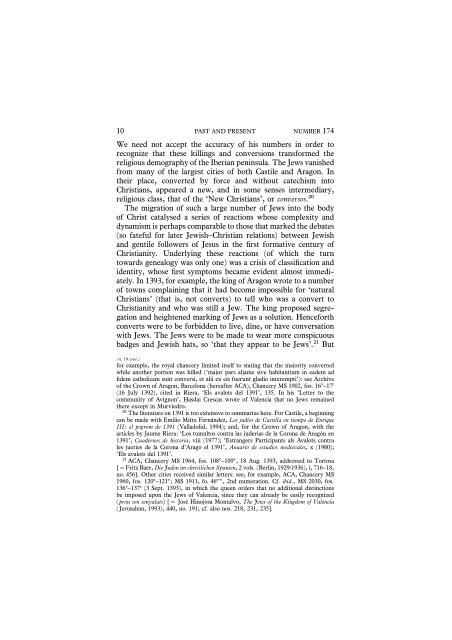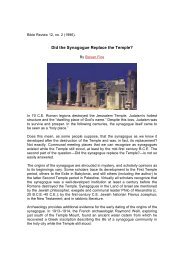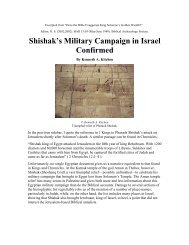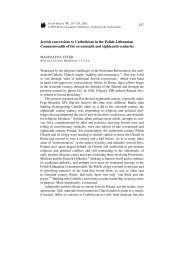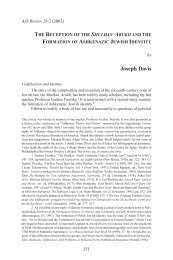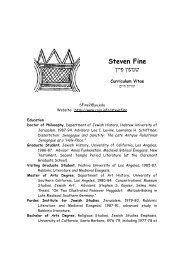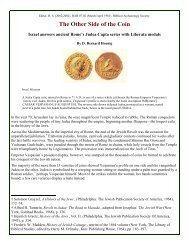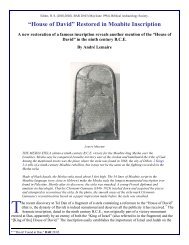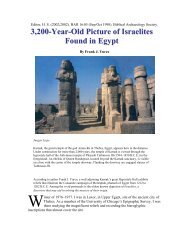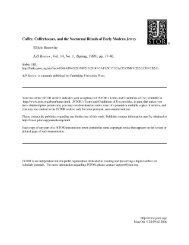jews and christians in fifteenth-century spain
jews and christians in fifteenth-century spain
jews and christians in fifteenth-century spain
You also want an ePaper? Increase the reach of your titles
YUMPU automatically turns print PDFs into web optimized ePapers that Google loves.
10 PAST AND PRESENT NUMBER 174<br />
We need not accept the accuracy of his numbers <strong>in</strong> order to<br />
recognize that these kill<strong>in</strong>gs <strong>and</strong> conversions transformed the<br />
religious demography of the Iberian pen<strong>in</strong>sula. The Jews vanished<br />
from many of the largest cities of both Castile <strong>and</strong> Aragon. In<br />
their place, converted by force <strong>and</strong> without catechism <strong>in</strong>to<br />
Christians, appeared a new, <strong>and</strong> <strong>in</strong> some senses <strong>in</strong>termediary,<br />
religious class, that of the ‘New Christians’, or conversos.20<br />
The migration of such a large number of Jews <strong>in</strong>to the body<br />
of Christ catalysed a series of reactions whose complexity <strong>and</strong><br />
dynamism is perhaps comparable to those that marked the debates<br />
(so fateful for later Jewish–Christian relations) between Jewish<br />
<strong>and</strong> gentile followers of Jesus <strong>in</strong> the first formative <strong>century</strong> of<br />
Christianity. Underly<strong>in</strong>g these reactions (of which the turn<br />
towards genealogy was only one) was a crisis of classification <strong>and</strong><br />
identity, whose first symptoms became evident almost immediately.<br />
In 1393, for example, the k<strong>in</strong>g of Aragon wrote to a number<br />
of towns compla<strong>in</strong><strong>in</strong>g that it had become impossible for ‘natural<br />
Christians’ (that is, not converts) to tell who was a convert to<br />
Christianity <strong>and</strong> who was still a Jew. The k<strong>in</strong>g proposed segregation<br />
<strong>and</strong> heightened mark<strong>in</strong>g of Jews as a solution. Henceforth<br />
converts were to be forbidden to live, d<strong>in</strong>e, or have conversation<br />
with Jews. The Jews were to be made to wear more conspicuous<br />
badges <strong>and</strong> Jewish hats, so ‘that they appear to be Jews’.21 But<br />
(n. 19 cont.)<br />
for example, the royal chancery limited itself to stat<strong>in</strong>g that the majority converted<br />
while another portion was killed (‘major pars aljame sive habitantium <strong>in</strong> eadem ad<br />
fidem catholicam sunt conversi, et alii ex eis fuerunt gladio <strong>in</strong>terempti’): see Archive<br />
of the Crown of Aragon, Barcelona (hereafter ACA), Chancery MS 1902, fos. 16v–17r<br />
(16 July 1392), cited <strong>in</strong> Riera, ‘Els avalots del 1391’, 135. In his ‘Letter to the<br />
community of Avignon’, H1 asdai Crescas wrote of Valencia that no Jews rema<strong>in</strong>ed<br />
there except <strong>in</strong> Murviedro.<br />
20 The literature on 1391 is too extensive to summarize here. For Castile, a beg<strong>in</strong>n<strong>in</strong>g<br />
can be made with Emilio Mitre Fernández, Los judíos de Castilla en tiempo de Enrique<br />
III: el pogrom de 1391 (Valladolid, 1994); <strong>and</strong>, for the Crown of Aragon, with the<br />
articles by Jaume Riera: ‘Los tumultos contra las juderias de la Corona de Aragón en<br />
1391’, Cuadernos de historia, viii (1977); ‘Estrangers Participants als Avalots contra<br />
les jueries de la Corona d’Aragó el 1391’, Anuario de estudios medievales, x (1980);<br />
‘Els avalots del 1391’.<br />
21 ACA, Chancery MS 1964, fos. 108v–109v, 18 Aug. 1393, addressed to Tortosa<br />
[=Fritz Baer, Die Juden im christlichen Spanien, 2 vols. (Berl<strong>in</strong>, 1929/1936), i, 716–18,<br />
no. 456]. Other cities received similar letters: see, for example, ACA, Chancery MS<br />
1960, fos. 120v–121v; MS 1911, fo. 46r–v, 2nd numeration. Cf. ibid., MS 2030, fos.<br />
136v–137r (3 Sept. 1393), <strong>in</strong> which the queen orders that no additional dist<strong>in</strong>ctions<br />
be imposed upon the Jews of Valencia, s<strong>in</strong>ce they can already be easily recognized<br />
(prou son senyalats) [= José H<strong>in</strong>ojosa Montalvo, The Jews of the K<strong>in</strong>gdom of Valencia<br />
(Jerusalem, 1993), 440, no. 191; cf. also nos. 218, 231, 235].


